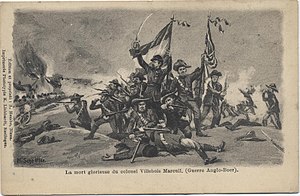Battle of Boshof
| Battle of Boshof | |||||||
|---|---|---|---|---|---|---|---|
| Part of Second Boer War | |||||||
 French postcard depicting The glorious death of Comte de Villebois-Mareuil at the Battle of Boshof, 1900 | |||||||
| |||||||
| Belligerents | |||||||
|
|
| ||||||
| Commanders and leaders | |||||||
|
|
| ||||||
| Strength | |||||||
| 750 men[1] | 120 men | ||||||
| Casualties and losses | |||||||
| 3 killed & 10 wounded[2] |
11 killed 64 captured & wounded | ||||||
The Battle of Boshof was fought during the Second Boer War on 5 April 1900 between British forces and mostly French volunteers of the Boer army.[3]
Events[edit]
Background[edit]
Following the Battle of Paardeberg (18–27 February), the relief of Kimberley and Ladysmith and the fall of Bloemfontein, General Frederick Roberts reorganised his force to pursue the defeated Boers. At the same time Lieutenant general Paul Methuen was tasked with clearing the country along the Vaal River on the Boers' flank and to drive towards Mafeking, which was still besieged.[4]
On 5 April Methuen ordered Brigadier-General Lord Chesham, with the Kimberley Mounted Corps and 4th Battery RFA.[5] From an informer they found intelligence on a Boer Commando unit led by a French volunteer, the Comte de Villebois-Mareuil.[6] Methuen was given information that the Boer unit intended to attack the British at Boshof near Tweefontein. The newly formed Imperial Yeomanry 3rd and 10th battalions, was given the task to surround the Boers. De Villebois-Mareuil, was in charge of the French legion volunteers which had 75 foreign volunteers most of whom were of the French but included a number of German, Dutch, Americans and one Russian Prince.[7]
Battle[edit]

De Villebois-Mareuil's force lay on two small hills (or Kopjes) - the foreign volunteers on one and the Boers on the other.[1] By 3pm the British force were setting up positions around the hills. A bombardment by four 15 pounder guns then commenced, along with suppressing fire by a Maxim machine gun.[8]
As the yeomanry prepared to close with the bayonet, the Boers on the hill saw that they were being outflanked and asked De Villebois-Mareuil to withdraw but he flatly refused. He was hoping for a thunderstorm which was coming their way to aid him. The pounding increased the casualties and the Boers saw the hopelessness of the situation - they mounted their horses and fought their way out. De Villebois-Mareuil and the French were left to attempt to make a gallant but futile last stand. The Kimberley Mounted Corps crept up on the right and the rest of the Yeomen dismounted and did the same on the left.[8] Both sides were close and the British artillery had to be careful when firing in order not to hit their own men. Some of the French tried to escape by mounting horses but were all taken down easily in a hail of rifle fire. Still the rest refused to surrender. Nevertheless, the Yeomanry took advantage and moved through the bushes and boulders around the hills. They slowly crept up ever closer, and casualties were light.[1] Within a few hours of fighting De Villebois-Mareuil was killed by a shell and morale sank amongst the volunteers. Seeing the panic the Yeomanry now only within fifteen yards of the fortified positions fixed bayonets and charged.[6]

By 6pm with darkness having approached the volunteers waved a white flag and the surviving volunteers surrendered. The thunderstorm that could have covered their retreat then came across the battlefield.[7] The battle lasted only three hours - in all eleven of the volunteers were killed, the rest were wounded and captured. De Villebois-Mareuil's Aide-de-camp Comté Pierre de Bréda was captured and was treated with chivalry by Methuen. In addition Prince Bagration of Tiflis, a Russian volunteer was killed. British losses were three killed and ten wounded.[2]
Aftermath[edit]
One week after his death the Boer Foreign Legion was disbanded and placed under General De la Rey to continue with the Guerilla Phase of the War.[4]
The battle was the first time that the Imperial Horse Yeomanry had fought and was also their first victory.[9]
British troops buried De Villebois-Mareuil with full military honours. A mass was arranged by the Ligue de la patrie française which was held in his honour at the Notre Dame de Paris which 10,000 people attended.[6] De Villebois-Mareuil's horse was taken to Britain by Lord Chesham, where it lived until February 1911.
A monument was later erected on the Farm Middelkuil, ten kilometres East of Boshof, where the battle took place, to commemorate battle.[7]
References[edit]
- ^ a b c Bennett pp. 10-04
- ^ a b Becket pp 210-11
- ^ Jaques p. 155
- ^ a b Mace & Grehan p.176
- ^ "No. 27155". The London Gazette. 19 January 1900. p. 362.
- ^ a b c Davitt, Michael (1902). The Boer Fight for Freedom. Funk & Wagnalls. p. 311.
- ^ a b c Miller pp 184-6.
- ^ a b Macnab pp. 198-202
- ^ Liddell Hart Centre for Military Archives, retrieved 2007-07-02
- Bibliography
- Beckett, Ian (2003). The Victorians at War. Cambridge University Press. p. 203. ISBN 1-85285-275-5.
- Bennett, William (1999). Absent Minded Beggars Volunteers in the Boer War. Pen and Sword. ISBN 9780850526851.
- Jaques, Tony (2006). Dictionary of Battles and Sieges: A Guide to 8500 Battles from Antiquity Through the Twenty-first Century. Greenwood Press. ISBN 978-0313335365.
- Macnab, Roy (1975). The French Colonel: Villebois-Mareuil and the Boers, 1899-1900. Oxford University Press. ISBN 9780195700459.
- Mace, Martin; Grehan, John (2014). The Boer War 1899-1902: Ladysmith, Megersfontein, Spion Kop, Kimberley and Mafeking Despatches from the front. Pen and Sword. ISBN 9781473838185.
- Miller, Stephen M (2012). Lord Methuen and the British Army: Failure and Redemption in South Africa. Routledge. ISBN 9780714644608.
